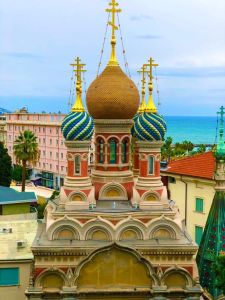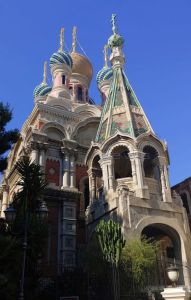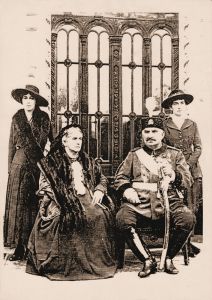Cathedral of Christ the Saviour for the Russian Community
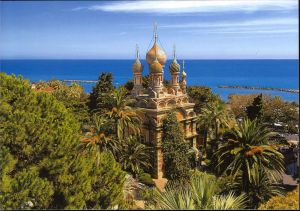
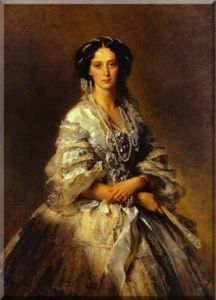 The initiative for the construction of a religious building in Sanremo, to be used as a place of worship for the large local Russian community of the Orthodox faith, started from the Empress Mother Maria Fërodovna, widow of Alexander III and mother of Nicholas II, with the approval of the Procurator of the Holy Synod Vladimir K. Sabler, also to adequately commemorate the stay in Matuzia between 1874 and 1875 of Empress Maria Aleksandrovna, consort of Tsar Alexander II, who had left a good memory in the city, so much so that the Municipal Administration, presided over by Mayor Stefano Roverizio of Roccasterone, had decided to name the course adorned with the palms she had donated to the city, precisely to the Russian sovereign.
The initiative for the construction of a religious building in Sanremo, to be used as a place of worship for the large local Russian community of the Orthodox faith, started from the Empress Mother Maria Fërodovna, widow of Alexander III and mother of Nicholas II, with the approval of the Procurator of the Holy Synod Vladimir K. Sabler, also to adequately commemorate the stay in Matuzia between 1874 and 1875 of Empress Maria Aleksandrovna, consort of Tsar Alexander II, who had left a good memory in the city, so much so that the Municipal Administration, presided over by Mayor Stefano Roverizio of Roccasterone, had decided to name the course adorned with the palms she had donated to the city, precisely to the Russian sovereign.
Even before the new church was built, the Russian community of Sanremo already had a small chapel for Orthodox worship, inaugurated on 21 February 1910 in the house of the Ermiglia brothers in Via Roma, number 22, in the presence of the Orthodox bishop Vladimir and various Russian notables from Nice and Menton, of whom Mr. Cheremtief was elected starosta (mayor).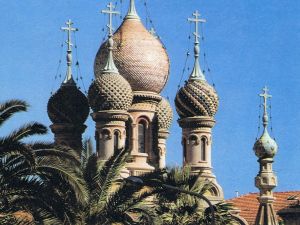 The project was entrusted to a very famous and esteemed Russian architect, the academic Aleksej V. Sucev, who was inspired by the style of the famous
The project was entrusted to a very famous and esteemed Russian architect, the academic Aleksej V. Sucev, who was inspired by the style of the famous 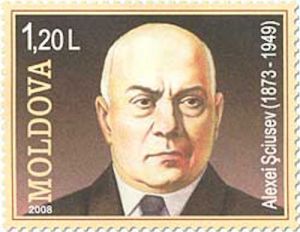 Moscow church of San Basilio and availed himself of the valuable collaboration of local engineers Pietro Agosti (son of a Russian mother) and Franco Tornatore, who prepared the final design of the new church, in which they were able to harmoniously blend different styles, such as neo-Moresque, neo-Binzatine and neoclassical, obtaining a fascinating effect thanks to the evocative interweaving of the colours of the five bulb domes and the spire.
Moscow church of San Basilio and availed himself of the valuable collaboration of local engineers Pietro Agosti (son of a Russian mother) and Franco Tornatore, who prepared the final design of the new church, in which they were able to harmoniously blend different styles, such as neo-Moresque, neo-Binzatine and neoclassical, obtaining a fascinating effect thanks to the evocative interweaving of the colours of the five bulb domes and the spire.
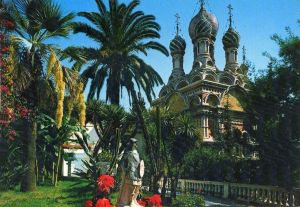 In the meantime, in November 1912, the committee promoting the erection of the new sacred building was launched, to which, in addition to personalities from the institutions, also numerous private citizens joined the committee who gave their active contribution to the realization of the enterprise, so much so that the committee received substantial donations of money from Russia and many other countries, so it can be said that the church was erected thanks also to the commitment and devotion of many Orthodox faithful all over the world.
In the meantime, in November 1912, the committee promoting the erection of the new sacred building was launched, to which, in addition to personalities from the institutions, also numerous private citizens joined the committee who gave their active contribution to the realization of the enterprise, so much so that the committee received substantial donations of money from Russia and many other countries, so it can be said that the church was erected thanks also to the commitment and devotion of many Orthodox faithful all over the world.
The committee therefore included, in addition to the president Count Giuseppe Tallevici, who had, among other things, provided his own land for the construction of the new building, and his Russian-born wife Countess Anna Tarasova, Mrs. Anna Suchanina, Théophile Debraud, Count Seremetev, the Russian vice-consul in Sanremo Giorgio de Thillot, the engineers Agosti and Tornatore and the Moscow architect Sucev, the aforementioned first designer of the church, while the council of fabbriceria was made up of the Russian ambassador to Italy Anatolij Krupenskij and the Consul General of Russia in Genoa Prince A. L. Gagarin, the mayor of Sanremo Alfredo Natta Soleri, the sub-prefect Bodo d'Albaretto, the pope of the Russian church in Florence and various personalities of the local Russian colony, including Count del Castillo, Countess Olsuf'eva, General Trouth, Mr. Petrov and Mrs. Sipjagin.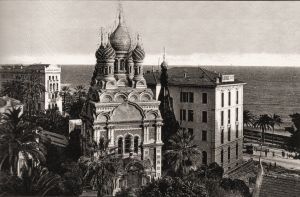 On 9 December 1912 the foundation stone laying ceremony of the new building was held, in which among others the ladies de Nepljuev, the princes Bagration, Baron de Karamicev and his wife, Count Vladimir Gurovsky, Mrs. Mlinkovskij, Dr. Asvadurov, General Boris de Kolombakin and his wife, Mrs. Kostomarov, Miss Anna de Tulupov, Mrs. Daziarov and Generaless Kotonev took part. After the start of the work, the reinforced concrete construction of the church was completed in one hundred working days by a team of workers and labourers from the Vernassa company led by the assistant Francesco Malacrida.
On 9 December 1912 the foundation stone laying ceremony of the new building was held, in which among others the ladies de Nepljuev, the princes Bagration, Baron de Karamicev and his wife, Count Vladimir Gurovsky, Mrs. Mlinkovskij, Dr. Asvadurov, General Boris de Kolombakin and his wife, Mrs. Kostomarov, Miss Anna de Tulupov, Mrs. Daziarov and Generaless Kotonev took part. After the start of the work, the reinforced concrete construction of the church was completed in one hundred working days by a team of workers and labourers from the Vernassa company led by the assistant Francesco Malacrida. 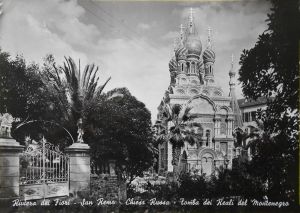 On 23 December 1913 the solemn inauguration of the new church took place, dedicated to St. Catherine the martyr and the thaumaturge saint Seraphim of Sarov - even though it is commonly known as the Church of Christ the Saviour - and opened on the same day for regular Russian Orthodox worship.
On 23 December 1913 the solemn inauguration of the new church took place, dedicated to St. Catherine the martyr and the thaumaturge saint Seraphim of Sarov - even though it is commonly known as the Church of Christ the Saviour - and opened on the same day for regular Russian Orthodox worship.
The inauguration ceremony was attended by Ambassador Krupensky, the Russian Consul in Genoa, Gagarin, the Deputy Consul of Russia in the city of Thillot, the Prefect of Porto Maurizio Pesce, the sub-prefect of Sanremo Bodo d'Albaretto, and the Prefectural Commissioner Luigi De Lachenal.
The church was consecrated by the Orthodox Bishop of Polock Vladimir, assisted by the Archimandrite Philipp, resident in Rome, and other priests during a religious service that lasted over three hours and was accompanied by liturgical chants of the Byzantine-Slavic rite performed by a choir of singers from the Russian churches of Menton and Nice; during the ceremony the Countesses Tallevici raised the then conspicuous sum of 1800 lire for the church.
After the inauguration, a sumptuous banquet was held at the Savoy Hotel at the invitation of the chairman of the committee for the erection of the church, Count Tallevici, during which the Russian national anthem was sung, followed by the notes of the Italian Royal March, after which the Russian ambassador to Italy, Krupenskij, openly praised the excellent relations between Russia and Italy, as well as the great merits of Count Tallevici and engineer Agosti in the erection of the new building, announcing the sending of a telegram to Tsar Nicholas II, who was then in Levadija, with expressions of sincere homage from the committee for the erection of the church and the Russian colony of Matusia. 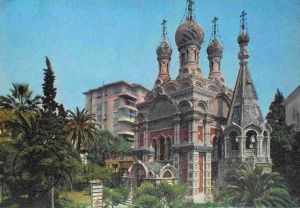
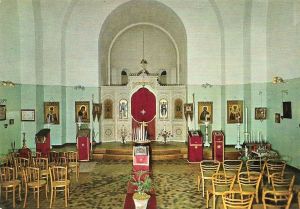 The present building comprises three buildings in communication with each other: the church proper, rectangular in shape, composed of the large central nave reserved for the faithful, the apse area arranged as a hemicycle, separated from the nave by a partition wall, in which three large doors open, the central one, or the Tsar's door, closed by an iron gate one metre high, and the sacristy, in which various sacred objects are kept.
The present building comprises three buildings in communication with each other: the church proper, rectangular in shape, composed of the large central nave reserved for the faithful, the apse area arranged as a hemicycle, separated from the nave by a partition wall, in which three large doors open, the central one, or the Tsar's door, closed by an iron gate one metre high, and the sacristy, in which various sacred objects are kept.
The church is surmounted by the characteristic five polychrome golden domes with a blue roof, at the top of which are placed the typical Russian three-armed crosses, and of which the central one, taller than the others, rises about fifty metres above the ground, while the octagonal bell tower, situated next to the church on the southern side of the building, has five small bells.
![]()
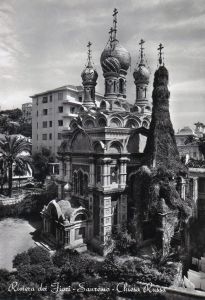 On the occasion of the inauguration, numerous religious objects, both votive and ornamental, were also donated to the administrators of the sacred building, including two icons of the Saviour and the Mother of God, faithful copies of paintings by the famous painter Viktor M. Vasnecov, currently on display in St. Vladimiro Cathedral in Kiev, offered by Mrs. Pauwers, and, like the paintings of the Russian city, placed on either side of the so-called "royal gates".
On the occasion of the inauguration, numerous religious objects, both votive and ornamental, were also donated to the administrators of the sacred building, including two icons of the Saviour and the Mother of God, faithful copies of paintings by the famous painter Viktor M. Vasnecov, currently on display in St. Vladimiro Cathedral in Kiev, offered by Mrs. Pauwers, and, like the paintings of the Russian city, placed on either side of the so-called "royal gates".
In particular, the Tallevici couple donated furniture, furnishings, vases and sacred ornaments, ritual objects and various icons of considerable value to the church.
The outbreak of the Great War and subsequent events, among which in particular the fall of the Tsarist regime, prevented the completion of the interior decoration with the creation of a series of frescoes, according to the original plan for the construction of the church, whose interior is still completely bare today, although it represents the obligatory reference point for Russian tourists passing through our city.
During the last World War the building suffered serious damage due to aerial bombardments, which were then repaired immediately after the war by the Municipal Administration, thus allowing the church to save itself from destruction.
In 1921, in the crypt of the building, the corpses of the Montenegrin royal family Nicola I Petrovic Njegos, his wife Milena, parents of the Queen of Italy Elena of Savoy, and their daughters Vera and Xenia, who died in exile like their parents, were buried in the Sanremo church.
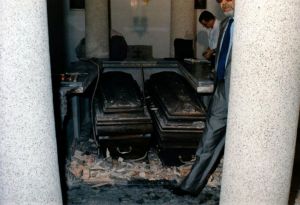
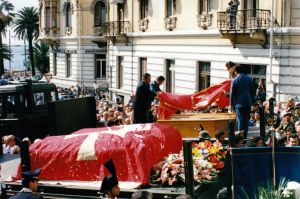 On 29 September 1989 the mortal remains of the Montenegrin royalty were then moved with a solemn ceremony to their home country, after sixty-eight years of rest on Italian soil in Sanremo, where King Nicholas had expressly asked to be buried together with his wife and daughters.
On 29 September 1989 the mortal remains of the Montenegrin royalty were then moved with a solemn ceremony to their home country, after sixty-eight years of rest on Italian soil in Sanremo, where King Nicholas had expressly asked to be buried together with his wife and daughters.
Also in 1989 two bronze busts were placed in the garden of the church, depicting the King of Italy Vittorio Emanuele III and Queen Elena, made in 1930 by the sculptor Monti on a model by F. Johnson and remained for a long time in a warehouse, where they had been transferred after the fall of the monarchy in Italy.
Orthodox liturgical services are still held in the church on public holidays.
(sources: text elaboration by A.Gandolfo; images from the web and the weight archive)
Updating:
The restoration work on the Church of Christ the Saviour, better known as the Russian Orthodox Church of Sanremo, has been completed.
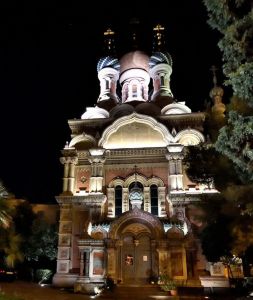 After many years from the last renovation works inside and outside the structure, in 2014 the interventions, recently completed, have started.
After many years from the last renovation works inside and outside the structure, in 2014 the interventions, recently completed, have started.
"During the Second World War - Father Sergio Mainoldi, rector of the Russian Orthodox Church of Sanremo, explained at the beginning of the works - the domes were damaged by an explosion.
In the reconstruction of this external part of the church we discovered that the crosses were gilded. We also found precious icons in the external niches of the church, depicting angels, which with the erosion of salt and time, were almost completely lost".
But what is inside? The celebration hall is frescoed according to orthodox iconography. "Our iconographer is Alexander Molchanov, from St. Petersburg - said Father Denis Baikov - but resident in Nice. The altar was frescoed with scenes from the life of Jesus and Mary and the faces of the four evangelists. In the last part, to be finished, which will be ready soon, scenes from the Apocalypse will be depicted".
These are in fact the frescoes that were not executed at the time of the construction of the church, as the Orthodox Community of the time found itself in serious financial difficulties following the Russian Revolution.
With the new wave of Russians in Sanremo, the possibilities of restoration that the Orthodox community is now facing are also returning.
According to tradition, the church is oriented towards the East. The apse is attached to the eastern part, the narthex to the western part, while the bell tower stands out near the southern wall. The overall height of the building, including the cross, is about 50 metres.
(Taken from "SanremoNews", article of 12 September 2020; Photo by Tonino Bonomo)





